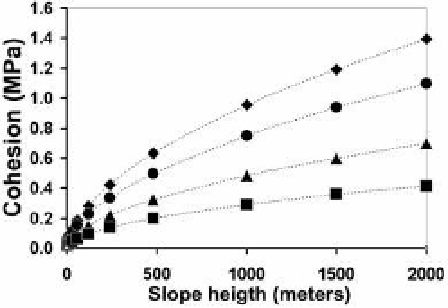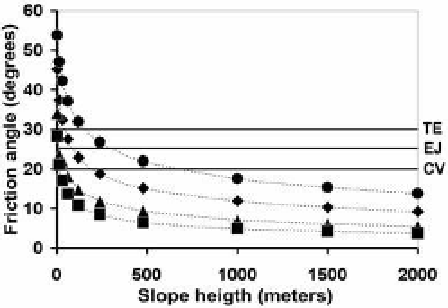Environmental Engineering Reference
In-Depth Information
Under the most unfavorable geological condi-
tions (low values of Gsi), cohesion and friction
angle suffer significant decrease in the same type
of rock massifs. That would imply a situation of
instability for the areas highlighted in this paper
equivalent reductions on the Gsi may be
assumed as a result of internal decomposition of
the rock mass usually accompanied by generalised
secondary fracturing.
if we assume the cohesion as nearly zero and
the gravity as the main acting force, failure of
natural slopes may occur if the slope gradient
exceeds the friction angle of the rock mass. in
the case of the canary archipelago, the most
significant average slope gradients are found
in “el Julan” flank, “cumbre Vieja” rift zone
and “el Teide” stratovolcano. as illustrated in
the figure 3, friction angles for unaltered rock
masses are always larger than the slope gra-
dients and hence, lateral collapse would never
take place. however, due to the internal corro-
sion of rocky massifs or due to the presence of
dominant ignimbrite rock masses, friction angle
may become smaller than slope gradient as the
slope height rises to 700-1300 m. in this case and
exclusively from a geotechnical point of view, if
internal cohesion drops, conditions for potential
lateral collapse would occur. although the rock
massifs are not only constituted by rocky (highly
cohesive) or pyroclastic materials, it is expected
that the presence of low cemented pyroclasts and
certain alteration degree of the intact rock will
reduce the cohesion and friction angle of the
rock masses. in this sense, an increase of flank
instability is expected and hence, the likelihood
of sudden collapse of buried pyroclastic layers as
isotropic-like stress reaches their threshold value.
This is what it could take place at “el Teide”, “el
Julan” and “cumbre Vieja” areas, since weather-
ing of the intact rocks, joints affecting the rock
massifs, unfavourable dip of layers and certain
amount of weakly consolidated pyroclastic lay-
ers, reduce the internal cohesion (
Fig. 4
). Moreo-
ver, friction angles may drop to values below the
slope gradient, creating the conditions for flank
be reinforced by external factors such as massive
injection of volcanic fluids, massif distortion by
magma injection, groundwater pressurization
(elsworth & Voight, 1995) or terrain fracturing
induced by magma intrusion. Pre-existing frac-
tured zones would also increase the risk of slope
failures in certain locations such as the sector of
the “san andres” fault system in el hierro island,
considered as an aborted landslide (Day
et al
.,
1997). among the three sites where the geotech-
nical characterization of flank failure was carried
out, “cumbre Vieja” is the only one where previ-
ous works (Ward & Day, 2001) suggested a cata-
strophic scenario due to the failure of its west
flank by the displacement of hundred of cubic
kilometres of rock mass into the sea). This is a
possibility that should not be mistreated if the
volcanic system reactivates and a similar reflec-
tion should be kept in mind for the “el Julan”
flank, “Teide stratovolcano” and the landscape
affected by the “san andres” fault system whose
level of risk has been minimized. as concluding
remarks it may be stated the following.
Figure 4. Variation of cohesion (MPa) vs. slope height
(meters) for slope application on selected types of mas-
sifs for assumed Gsi lower than 30. Rhomboids: Fresh
massive lavas; triangles: Weathered massive lavas; circles:
ignimbrites; squares: low cemented pyroclasts.
Figure 5. Variation of the friction angle (degrees) vs.
slope height (meters) for slope application on selected
types of massifs for assumed Gsi lower than 30. Rhom-
boids: Fresh massive lavas; triangles: Weathered massive
lavas; circles: ignimbrites; squares: low cemented pyro-
clasts. The horizontal solid lines intersect the vertical axis
in the corresponding average value of slope angle on the
flanks of “Teide (Te)”, “el Julan (eJ)” and “cumbre
Vieja (cV)”.

















